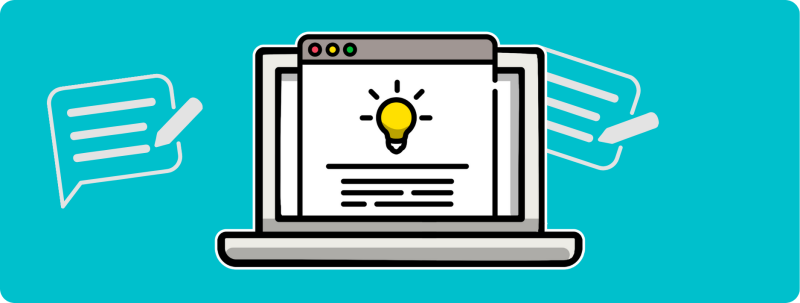Simple but successful ways to build your content marketing strategy
Written by Yilan Hua | 24th November 2023

Content marketing is a highly successful method of digital marketing that is used to engage and retain an audience. It has many benefits such as a higher ROI (return on investment), lower expenses, and long-term returns.
However, most of these benefits are only available to the people who were successful in their content marketing efforts. The downside is that content marketing is an ongoing process. It never really stops. You just have to keep doing it to reap the rewards.
In this article, we will explore a few simple tactics you can include in your content marketing strategy and examples of how other companies are seeing success.
However, most of these benefits are only available to the people who were successful in their content marketing efforts. The downside is that content marketing is an ongoing process. It never really stops. You just have to keep doing it to reap the rewards.
In this article, we will explore a few simple tactics you can include in your content marketing strategy and examples of how other companies are seeing success.
Creating a Successful Content Marketing Strategy
When building your content strategy, you must decide how to share information about your products/services to help you convert prospects into loyal customers.

1. Blogging
Blogging is the first thing that pops into anyone’s mind when they think about content marketing and for good reason. At this point, blogging is synonymous with content marketing, it is no longer the tool of a hobbyist as a way to engage with like-minded individuals. Instead, it is now used by companies and corporations as a way to engage with their audience and be seen as thought leaders in their space.
They use blogs to show the world and their audience that they are the experts in their field. It helps them build trust in the community and encourages their potential customers to come to them rather than their competition.
Blogging also has great SEO benefits. It is used to make a company’s website rank higher on the search engine results page (SERPs) so that it can get more organic traffic. Organic traffic makes up the brunt of website traffic (almost 51%). It usually includes new people who found the website through a Google search.
You have to target keywords that relate to your content and have a lot of impressions. These keywords need to be used throughout the blog posts naturally. Also, the content needs to be valuable and informative. If all these conditions are met, the blog post will be ranked higher for its targeted keywords, resulting in an influx of organic traffic.
HubSpot is a prime example of a company that uses blogging successfully. Their blog is full of educational content. It has helped HubSpot establish itself as a thought leader in the digital marketing sphere. They not only discuss CRMs (as that is what HubSpot provides), but they also provide tutorials on how to build websites, content about sales strategies, and even how to provide great customer service.

2. Email Marketing
Email marketing is an important part of any content marketing strategy. It provides a direct line to your potential customers to deliver important information. It’s also highly customizable, making it easy to take a targeted approach.
This means that you can send each of your customers exactly the type of content they would like. Emails are used in content marketing to keep the audience interested in your brand. After all, in this fast-paced world, irrelevance is the bane of a company’s existence. Email marketing can be used for both retaining older customers and bringing in new ones.
Let us talk about bringing in new customers. The important thing here is to keep your email extremely relevant to their perceived interests. You want to catch their attention from your subject line alone. Otherwise, your email will not be opened at all. To do that you need to write an engaging subject line. One best practice for creating the perfect subject line is to startby writing a few different lines and then paraphrasing them to see if they can be improved.
There are even online tools you can use to make this easy! To rephrase sentences online free, you can simply search online for subject line paraphrasers and give them a try.
After the subject line comes the content itself, this also needs to be immaculate as poor content will not be enough to engage your audience. You can use paraphrasing tools again to ensure that catchy vocabulary and easy-to-read sentences captivate your audience are used in your content.
The Tonic is a great example of a brand that uses email marketing effectively. It is a brand that provides newsletters to its audience through emails. According to Ahrefs, The Tonic has a 33% open rate, and they send 5 emails per week. Doing the math, it comes out to a massive open rate as almost eighty-six of their emails are being opened out of the 260 they send out to one person per year.

3. Newsletters and E-Books
Newsletters and eBooks are methods of content marketing. They are a bit different from blogging because they are not usually used for inbound marketing. Rather they are more useful for targeted marketing. Just think about it, what do you send in an email to your consumer? You send them information that helps them make good decisions with respect to your products and services.
This information is neatly packaged in the form of an eBook or a newsletter. Just like a blog, you must ensure the information you share is highly valuable. It should provide actionable advice that can help your customers. If you are a B2B company, your content should reflect your unique value proposition to your customers, specifically how they can use your services/products to improve their profits.
Other ways of providing your customers with eBooks and newsletters are through your platforms. For example, you could provide your customers with a free eBook if they signed up on your platform. Or you could do a buy one gets one free bundle where one service/product nets the customers a free eBook.
You could offer a free newsletter for a limited time in return for signing up on your platforms. Just like with eBooks you can offer newsletter subscriptions and entice people to convert. The Tonic is yet again another great example of successfully employing newsletters as a content marketing strategy. They provide these newsletters through their stellar emails and get people interested in their brand.

4. Ad Campaigns
Ad campaigns can also be part of content marketing. That is because aside from the visual elements, a lot of copywriting is involved. While there are successful campaigns that use only visuals to make a successful narrative ad, those are rare and difficult to replicate because the novelty wears off quickly.
As such most ads have some compelling copy that includes a CTA (call to action) to make people more willing to convert. You can use this with other tactics on this list such as blogging. For example, you could create an ad that has eye-catching visuals and copy that says something like “Improve your mental health in 10 seconds” and link it to a blog post that addresses this title.
The copy in this particular case provided two key pieces of information to the reader. It let them know it would benefit them and that there was no big commitment involved. Running ads with exquisitely written copy can bring in some serious leads and help them enter the sales funnel.
A good example of a company that runs great ad campaigns using copy is Nike. Nike uses visuals that incite motivation to work on yourself and your body. They use iconic quotes like “Just do it” and “The Shoes works if you do” that entice readers of these ads to buy Nike products and start exercising/running.

5. User Generated Content
Nowadays both B2B and B2C audiences are more educated and typically research thoroughly before committing to purchase. When they want some specific solution that can be solved by your company, they will look online. That is where your content such as blogs and eBooks will snare them. However, a company still writes these things, so there is some level of distrust. However, there is little to no distrust when other customers generate the content.
This is user-generated content (UGC).UGC is great at generating trust from new leads. UGC can include all types of content such as photos, videos, designs, and even written content. Since our focus is on written content, we will provide examples related to them.
The most common examples are Amazon reviews of products and testimonials. An example of a company that uses UGC well is LeCol, which sells cycling gear. They combine pictures and reviews to provide the best UGC that instills confidence in the prospective customer. They ask their customers to provide pictures and reviews of their products.
Conclusion
So, you can use five simple and successful content marketing tactics to build a strategy that will get results. Give it a try and discover how your content marketing strategy will help you drive customer awareness, generate leads, and increase conversion.
Author's bio
This is Yilan Hua – an SEO enthusiast and a Content Writer by passion. I am writing what I have experienced.
I have published my writings on Education & Tech over the world’s known platforms.

